Chapter 2 The R Programming Environment
2.1 Ch. 2 Objectives
This chapter is designed around the following learning objectives. Upon completing this chapter, you should be able to:
- Define free and open source software and list some of its advantages over proprietary software
- Recognize the difference between R and RStudio
- Describe the differences between base R code that you initially download and “package” code that you use to expand base R
- Use RStudio to download and install a package from the Comprehensive R Archive Network (CRAN) to your computer
- Use RStudio to load a package that you have installed within an R session
- Demonstrate how to access help documentation including vignettes and helpfiles for a package and its functions
- Demonstrate how to submit R expressions at the console
- Define the general syntax for calling a function and for specifying both required and optional arguments for that function
- Describe what an R object is and how to assign an R object a name to reference it in later code
- Describe how to create vector objects of numeric and character classes
- Describe how to explore and extract elements from vector objects
- Describe how to create dataframe objects
- Describe how to explore and extract elements from dataframe objects
- Compare the key differences between running R code from the console versus writing and running R code in an R script
2.2 R and R Studio
2.2.1 What is R?
R in an open-source programming language that evolved from the S language. The S language was developed at Bell Labs in the 1970s, which is the same place (and about the same time) that the C programming language was developed.
R itself was developed in the 1990s-2000s at the University of Auckland. It is open-source software, freely and openly distributed under the GNU General Public License (GPL). The base version of R that you download when you install R on your computer includes the critical code for running R, but you can also install and run “packages” that people all over the world have developed to extend R.
With new developments, R is becoming more and more useful for a variety of programming tasks. It really shines in working with data and doing statistical analysis. R is currently popular in a number of fields, including statistics, machine learning, and data analysis.
R is an interpreted language. That means that you can communicate with it interactively from a command line. Other common interpreted languages include Python and Perl.
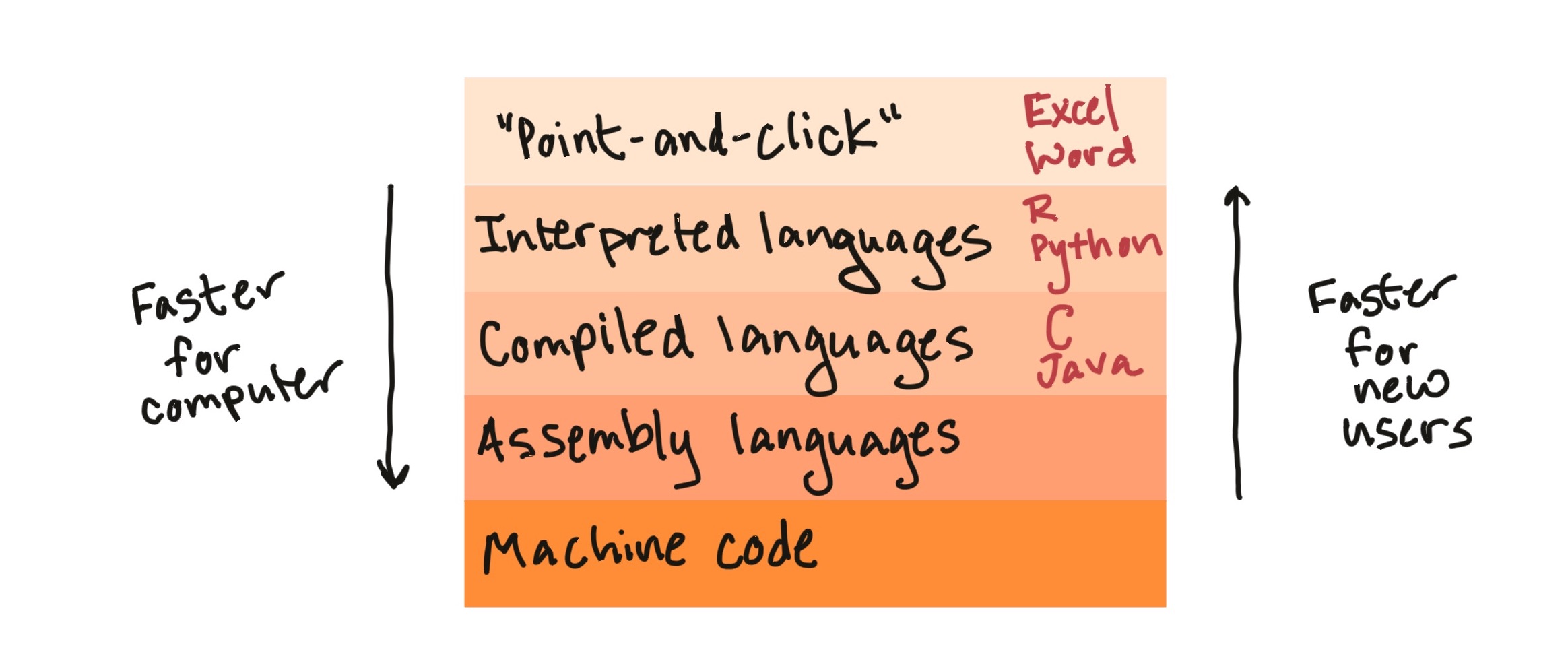
Figure 2.1: Broad types of software programs. R is an interpreted language. ‘Point-and-click’ programs, like Excel and Word, are often easiest for a new user to get started with, but are slower for the computer and are restricted in the functionality they offer. By contrast, compiled languages (like C and Java), assembly languages, and machine code are faster for the computer and allow you to create a wider range of things, but can take longer to code and take longer for a new user to learn to work with.
Compared to Python, R has some of the same strengths (e.g., quick and easy to code, interfaces well with other languages, easy to work interactively) and weaknesses (e.g., slower than compiled languages). For data-related tasks, R and Python are fairly neck-and-neck, with Julia an up-and-coming option. Nonetheless, R is still the first choice of statisticians in most fields, so I would argue that R has a an advantage, if you want to have access to cutting-edge statistical methods.
“The best thing about R is that it was developed by statisticians. The worst thing about R is that…it was developed by statisticians.” – Bo Cowgill, Google, at the Bay Area R Users Group
2.2.2 Free and open-source software
“Life is too short to run proprietary software.” – Bdale Garbee
R is free and open-source software. Conversely, many other popular statistical programming languages such as SAS and SPSS are proprietary. It’s useful to know what it means for software to be “open-source”, both conceptually and in terms of how you will be able to use and add to R in your own work.
R is free, and it’s tempting to think of open-source software just as “free software”. It is a little more subtle than that. It helps to consider some different meanings of the word “free”. “Free” can mean:
- Gratis: Free as in free beer
- Libre: Free as in free speech
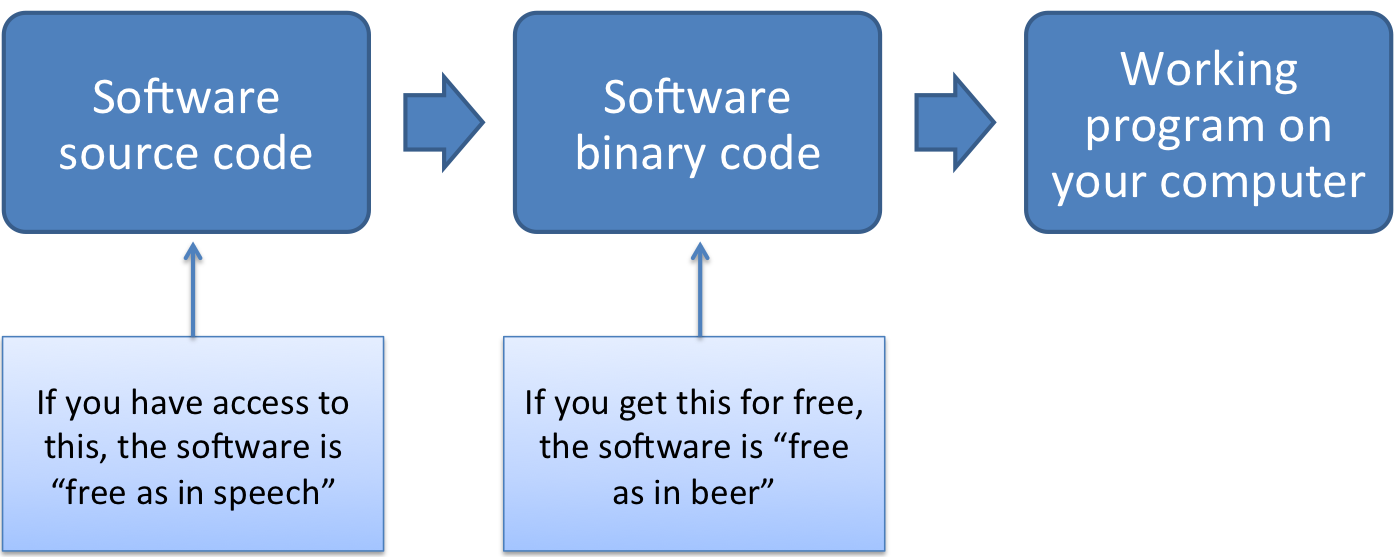
Figure 2.2: An overview of how software can be each type of free (beer and speech). For software programs developed using a compiled programming language, the final product that you open on your computer is run by machine-readable binary code. A developer can give you this code for free (as in beer) without sharing any of the original source code with you. This means you can’t dig in to figure out how the software works and how you can extend it. By contrast, open-source software (free as in speech) is software for which you have access to the human-readable code that was used as in input in creating the software binaries. With open-source code, you can figure out exactly how the program is coded.
Open-source software is the libre type of free (Figure 2.2). This means that, with software that is open-source, you can:
- Access all of the code that makes up the software
- Change the code as you’d like for your own applications
- Build on the code with your own extensions
- Share the software and its code, as well as your extensions, with others
Often, open-source software is also free, making it “free and open-source software”, or “FOSS”.
Popular open source licenses for R and R packages include the GPL and MIT licenses.
“Making Linux GPL’d was definitely the best thing I ever did.” – Linus Torvalds
In practice, this means that, once you are familiar with the software, you can dig deeply into the code to figure out exactly how it’s performing certain tasks. This can be useful for finding and eliminating bugs and can help researchers figure out if there are any limitations in how the code works for their specific research.
It also means that you can build your own software on top of existing R software and its extensions. I explain a bit more about R packages a bit later, but this open-source nature of R has created a large community of people worldwide who develop and share extensions to R. As a result, you can pull in packages that let you do all kinds of things in R, like visualizing Tweets, cleaning up accelerometer data, analyzing complex surveys, fitting machine learning models, and a wealth of other cool things.
“Despite its name, open-source software is less vulnerable to hacking than the secret, black box systems like those being used in polling places now. That’s because anyone can see how open-source systems operate. Bugs can be spotted and remedied, deterring those who would attempt attacks. This makes them much more secure than closed-source models like Microsoft’s, which only Microsoft employees can get into to fix.” – Woolsey and Fox. To Protect Voting, Use Open-Source Software. New York Times. August 3, 2017.
You can download the latest version of R from
CRAN. Be sure to select the
distribution for your
type of computer system. R is updated occasionally; you should plan to
re-install R at least once a year to make sure you’re working with one of the
newer versions. Check your current R version (e.g., by running sessionInfo()
at the R console) to make sure you’re not using an outdated version of R.
“The R engine …is pretty well uniformly excellent code but you have to take my word for that. Actually, you don’t. The whole engine is open source so, if you wish, you can check every line of it. If people were out to push dodgy software, this is not the way they’d go about it.” – Bill Venables, R-help (January 2004)
“Talk is cheap. Show me the code.” – Linus Torvalds
2.2.3 What is RStudio?
To get the R software, you’ll download R from the R Project for Statistical Computing. This is enough for you to use R on your own computer. But, for a more user-friendly experience, you should also download RStudio, an integrated development environment (IDE) for R. It provides you an interface for using R, with a lot of nice extras like R Projects that will make your life easier. All of the code chunks shown in this book were produced using RStudio.
As Chapter 1 outlined, you should download R first, then the RStudio IDE.
RStudio, PBC is a leader in the R community. Currently, the company:
- Develops and freely provides the RStudio IDE
- Provides excellent resources for learning and using R (e.g., cheat sheets, free online books)
- Is producing some of the popular R packages
- Employs some of the top people in R development
- Is a key member of The R Consortium in addition to others such as Microsoft, IBM, and Google
R has been advancing by leaps and bounds in terms of what it can do and the elegance with which it does it, in large part because of the enormous contributions of people involved with RStudio.
2.3 Communicating with R
Because R is an interpreted language, you can communicate with it interactively. You do this using the following general steps:
- Open an R session
- At the prompt in the console, enter an R expression
- Read R’s “response” (i.e., output)
- Repeat 2 and 3
- Close the R session
2.3.1 R sessions, console, and command prompt
An R session is an “instance” of you using R. To open an R session, double-click on the icon for the RStudio IDE on you computer. When RStudio opens, you will be in a “fresh” R session, unless you restore a saved session, which is not best practice. To avoid saving work sessions, you should change the defaults in RStudio’s Preferences menu, such that RStudio never saves the workspace to .RData on exit. A “fresh” R session means that, once you open RStudio, you will need to “set up” your session, including loading packages and importing data (discussed later).
In RStudio, the screen is divided into several “panes”. We’ll start with the pane called “Console”. The console lets you “talk” to R. This is where you can “talk” to R by typing an expression at the prompt (the caret symbol, “>”). You press the “Return” key to send this message to R.
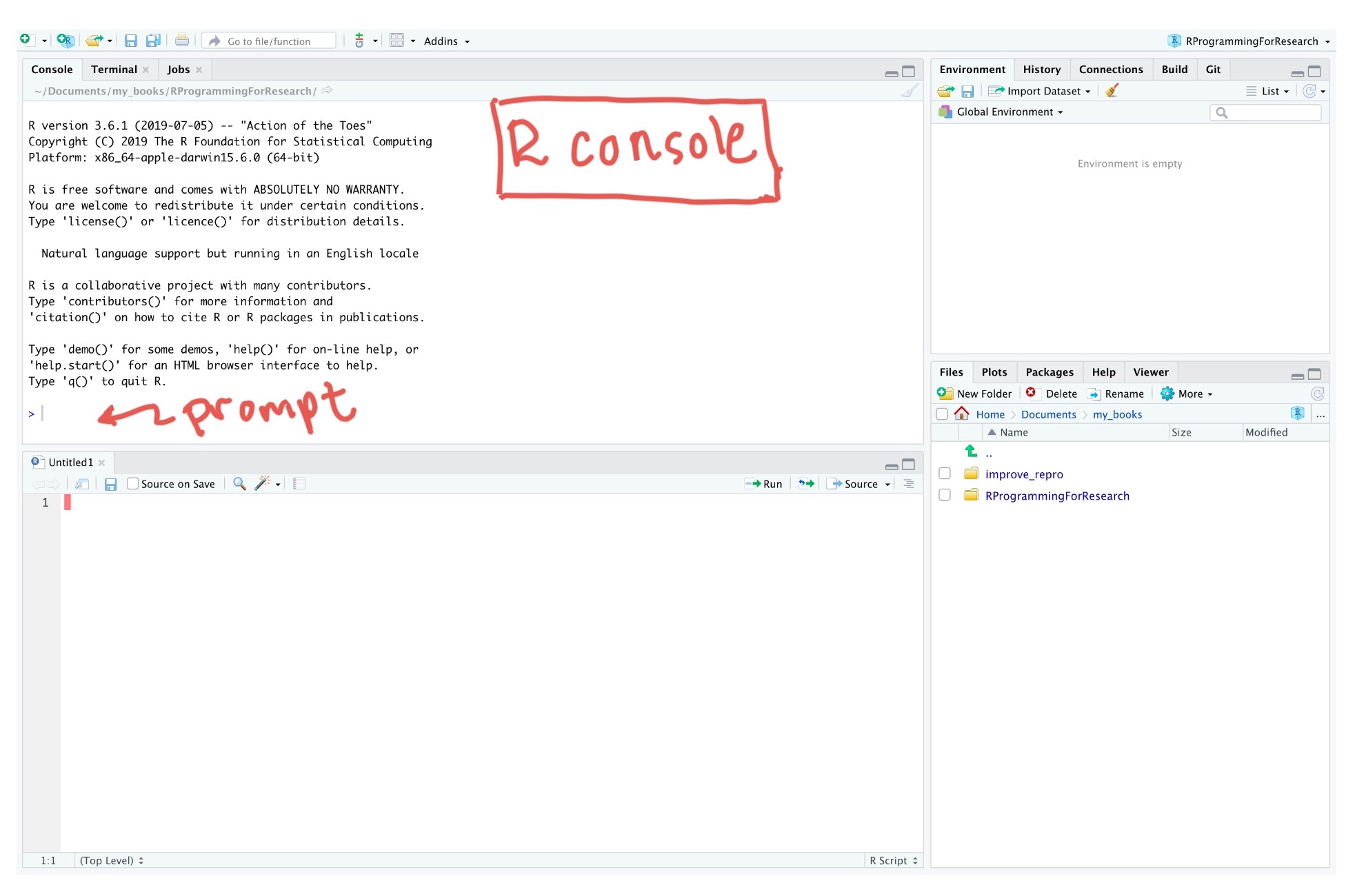
Figure 2.3: Finding the ‘Console’ pane and the command prompt in RStudio.
Once you press “Return”, R will respond in one of three ways:
- R does whatever you asked it to do with the expression and prints the output, if any, of doing that, as well as a new prompt so you can ask it something new.
- R doesn’t think you’ve finished asking for something, and instead of giving you a new prompt (“>”) it gives you a “+”. This means that R is still listening, waiting for you to finish asking it something.
- R tries to do what you asked it to, but it can’t. It gives you an error message, as well as a new prompt so you can try again or ask it something new.
2.3.2 R expressions, function calls, and objects
To “talk” with R, you need to know how to give it a complete expression. Most expressions you’ll want to give R will be some combination of two elements:
- Function calls
- Object assignments
We’ll go through both these pieces and also look at how you can combine them together for some expressions.
According to John Chambers, one of the creators of the S language (precursor to R):
- Everything that exists in R is an object
- Everything that happens in R is a call to a function
In general, function calls in R take the following structure:
# generic code (this won't run)
function_name(formal_argument_1 = named_argument_1,
formal_argument_2 = named_argument_2,
[etc.])Sometimes, we’ll show “generic” code in a code block, that doesn’t actually work if you put it in R, but instead shows the generic structure of an R call. We’ll try to always include a comment with any generic code, so you’ll know not to try to run it in R.
A function call forms a complete R expression, and the output will be the
result of running print() or show() on the object that is output by the
function call. Here is an example of this structure:
## [1] "Hello, world!"Figure 2.4 shows an example of the typical elements of a
function call. In this example, we’re calling a function with the name
print. It has one argument, with a formal argument of x, which in
this call we’ve provided the named argument: “Hello, world!”.
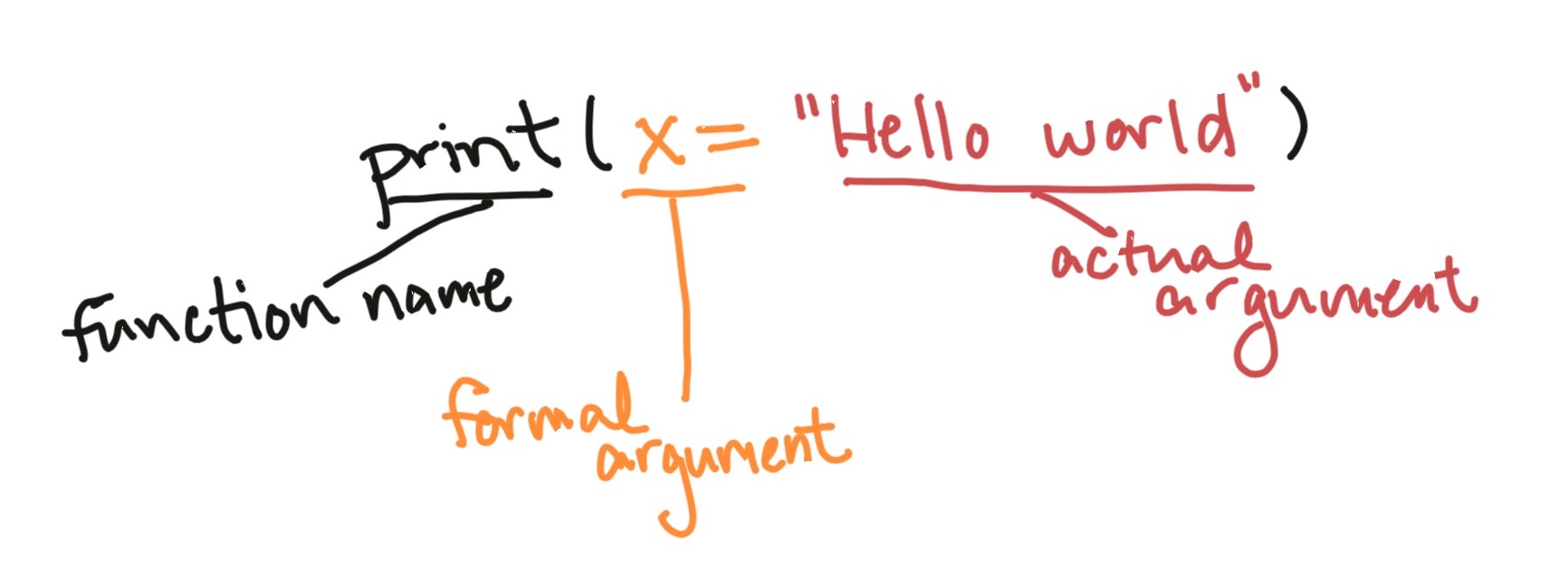
Figure 2.4: Main parts of a function call. This example is calling a function with the name ‘print’. The function call has one argument, with a formal argument of ‘x’, which in this call is provided the named argument ‘Hello world’.
The arguments are how you customize the call to an R function. For example,
you can use change the named argument value to print different messages with
the print() function. Note that the formal argument never changes.
## [1] "Hello, world!"## [1] "Hi, Fort Collins!"Some functions do not require any arguments. For example, the getRversion()
function will print out the version of R you are using.
## [1] '4.5.2'Some functions will accept multiple arguments. For example, the print()
function allows you to specify whether the output should include quotation
marks, using the quote formal argument:
## [1] "Hello world"## [1] Hello worldArguments can be required or optional.
For a required argument, if you don’t provide a value for the argument when you
call the function, R will respond with an error. For example, x is a
required argument for the print() function, so if you try to call the
function without it, you’ll get an error:
Error in print.default() : argument "x" is
missing, with no defaultFor an optional argument on the other hand, R knows a default value for that argument, so if you don’t give it a value for that argument, it will just use the default value provided by the R developer who wrote the function.
For example, for the print() function, the quote argument has the default
value TRUE. So if you don’t specify a value for that argument, R will assume
it should use quote = TRUE. That’s why the following two calls give the same
result:
## [1] "Hello, world!"## [1] "Hello, world!"Often, you’ll want to find out more about a function, including:
- Examples of how to use the function
- Which arguments you can include for the function
- Which arguments are required versus optional
- What the default values are for optional arguments
You can find out all this information in the function’s helpfile, which you
can access using the function ?. For example, the mean() function will let
you calculate the mean (average) of a group of numbers. To find out more about
this function, at the console type:
This will open a helpfile in the “Help” pane in RStudio. Figure 2.5 shows some of the key elements of an example helpfile, the
helpfile for the mean() function. In particular, the “Usage” section helps
you figure out which arguments are required and which are optional in
the Usage section of the helpfile.
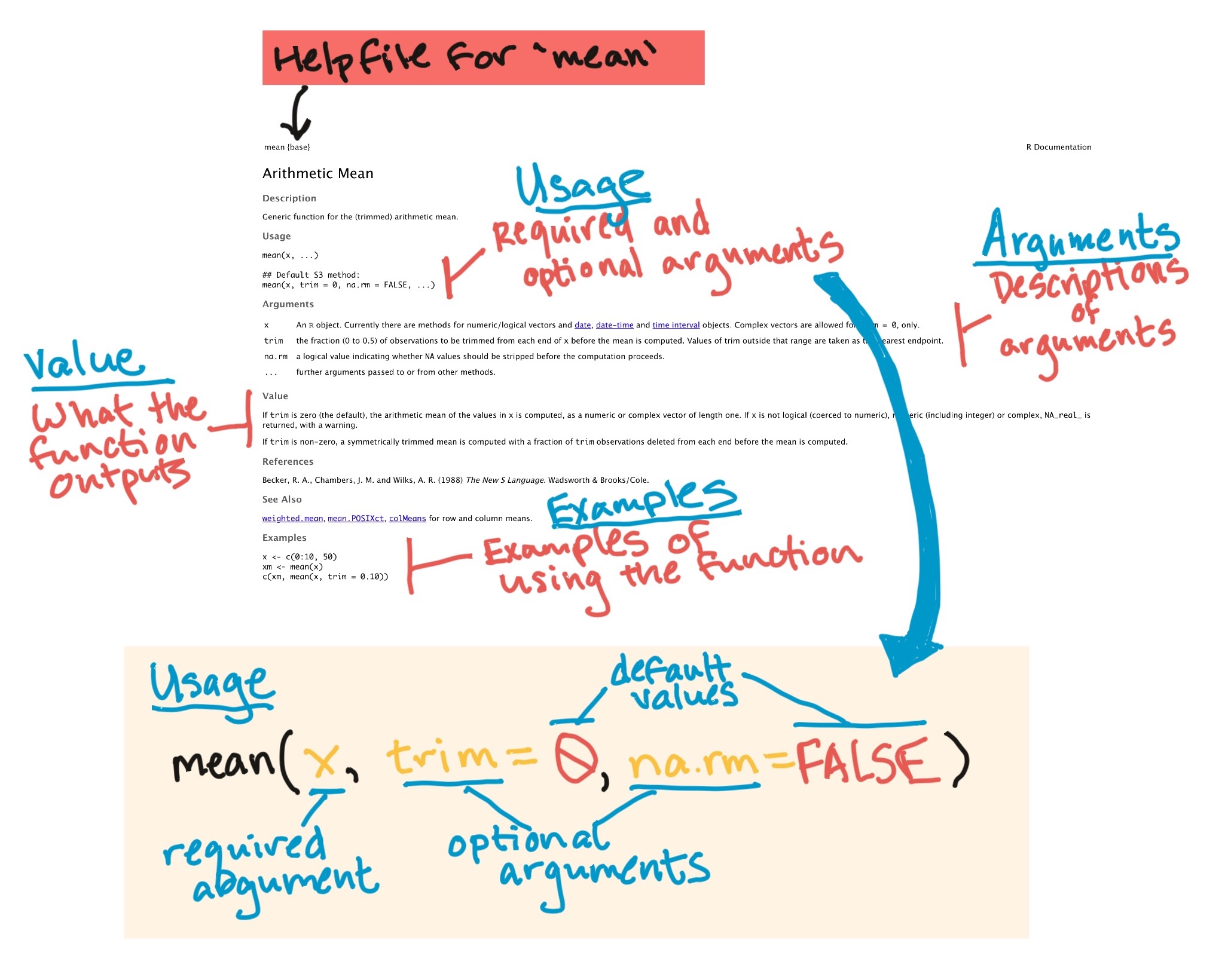
Figure 2.5: Navigating a helpfile. This example shows some key parts of the helpfile for the ‘mean’ function.
There’s one class of functions that looks a bit different from others. These
are the infix operator functions. Instead using parentheses after the
function name, they usually go between two arguments. One common example is
the + operator:
## [1] 5There are operators for several mathematical functions: +, -, *, /.
There are also other operators, including logical operators and
assignment operators, which we’ll cover later.
In R, a variety of different types and structures of data can be saved in objects. For right now, you can just think of an R object as a discrete container of data in R.
Function calls will produce an object. If you just call a function, as we’ve been doing, then R will respond by printing out that object. But, we often want to use that object more. For example, we might want to use it as an argument later in our “conversation” with R, when we call another function later. If you want to re-use the results of a function call later, you can assign that object to an object name. This kind of expression is called an assignment expression.
Once you do this, you can use that object name to refer to the object. This means that you don’t need to re-create the object each time you need it—instead, you can create it once, and then just reference it by name each time you need it after that. For example, you can read in data from an external file as a dataframe object and assign it an object name. Then, when you need that data later, you won’t need to read it in again from the external file.
The “gets arrow” (<-) is R’s assignment operator. It takes whatever
you’ve created on the right hand side of the <- and saves it as an object
with the name you put on the left hand side of the <-:
For example, if I just type "Hello, world!", R will print it back to me, but
it won’t save it anywhere for me to use later:
## [1] "Hello, world!"If I assign it to an object, I can “refer” to that object in a later
expression. For example, the code below assigns the object
"Hello, world!" the object name message. Later, I can just refer to
this object using the name message, for example in a function call to the
print() function:
## [1] "Hello, world!"When you enter an assignment expression like this at the R console, if everything goes right, then R will “respond” by giving you a new prompt, without any kind of message. There are three ways you can check to make sure that the object was successfully assigned to the object name:
- Enter the object’s name at the prompt and press return. The default if you
do this is for R to “respond” by calling the
print()function with that object as thexargument. - Call the
ls()function, which doesn’t require any arguments. This will list all the object names that have been assigned in the current R session. - Look in the “Environment” pane in RStudio. This also lists all the object names that have been assigned in the current R session.
Here are examples of these strategies:
- Enter the object’s name at the prompt and press return:
## [1] "Hello, world!"- Call the
ls()function:
## [1] "message"- Look in the “Environment” pane in RStudio (see Figure 2.6).
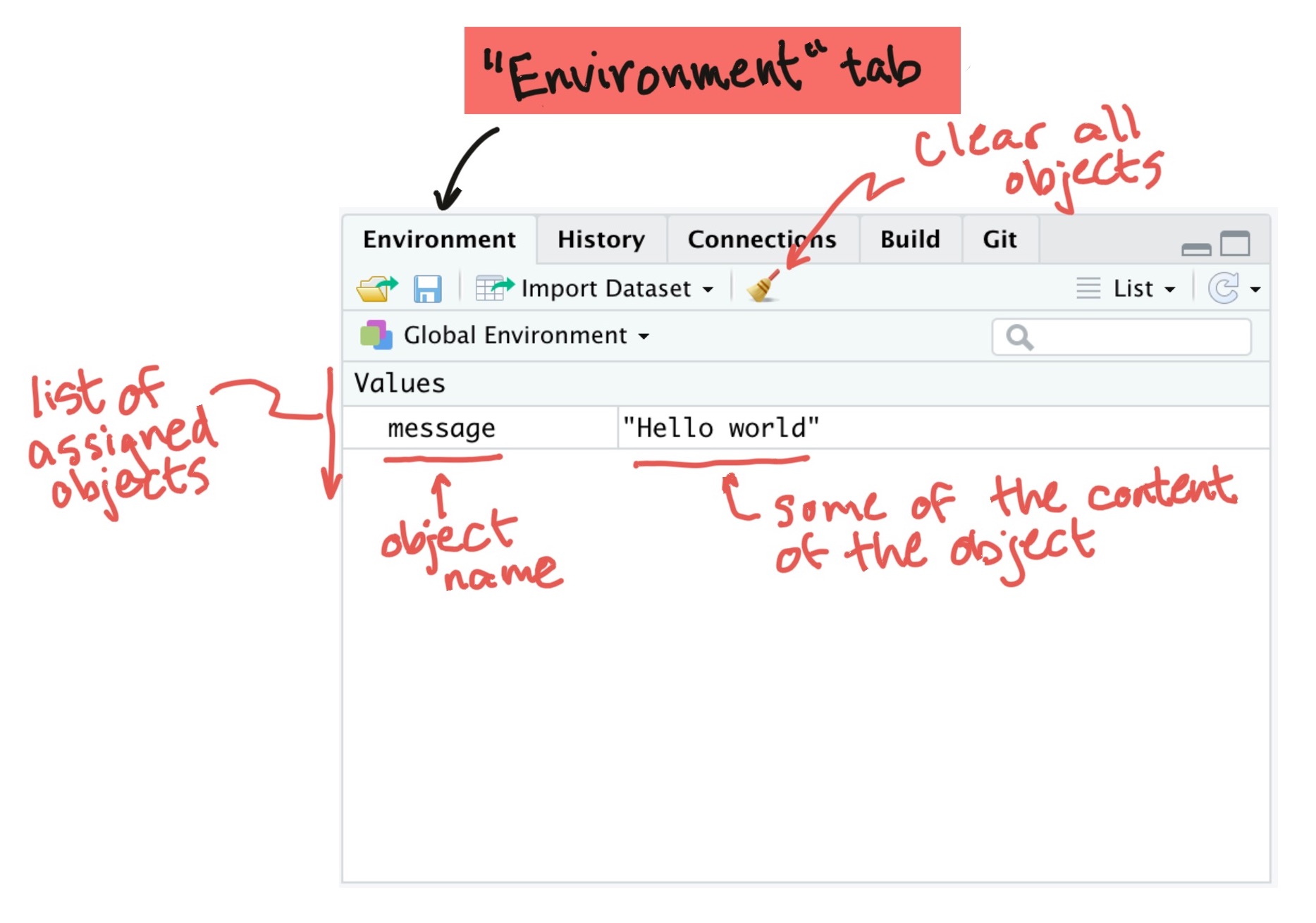
Figure 2.6: ‘Environment’ pane in RStudio. This shows the names and first few values of all objects that have been assigned to object names in the global environment.
You can make assignments in R using either the “gets arrow” (<-) or =. When
you read other people’s code, you’ll see both. R gurus advise using <- rather
than = when coding in R, because as you move to doing more complex things,
some subtle problems might crop up if you use =. You can tell the age of a
programmer by whether he or she uses the “gets arrow” or =, with = more
common among the young and hip. For this course, however, I am asking you to
code according to
Hadley Wickham’s R style guide,
which specifies using the “gets
arrow” for object assignment.
While the “gets arrow” takes two key strokes, you can somewhat get around this limitation by using RStudio’s keyboard shortcut for the “gets arrow”. This shortcut is Alt + - on Windows and Option + - on Macs. To see a full list of RStudio keyboard shortcuts, go to the “Help” tab in RStudio and select “Keyboard Shortcuts”.
There are some absolute rules for the names you can use for an object name:
- Use only letters, numbers, and underscores
- Don’t start with anything but a letter
If you try to assign an object to a name that doesn’t follow the “hard” rules, you’ll get an error. For example, all of these expressions will give you an error:
In addition to these fixed rules, there are also some guidelines for naming objects that you should adopt now, since they will make your life easier as you advance to writing more complex code in R. The following three guidelines for naming objects are from Hadley Wickham’s R style guide:
- Use lower case for variable names (
message, notMessage) - Use an underscore as a separator (
message_one, notmessageOne) - Avoid using names that are already defined in R (e.g., don’t name an object
mean, because amean()function exists)
“Don’t call your matrix ‘matrix’. Would you call your dog ‘dog’? Anyway, it might clash with the function ‘matrix’.” – Barry Rowlingson, R-help (October 2004)
Another good practice is to name objects after nouns (e.g., message) and
later, when you start writing functions, name those after verbs (e.g.,
print_message). You’ll want your object names to be short enough that they
don’t take forever to type as you’re coding, but not so short that you can’t
remember to what they refer.
Sometimes, you’ll want to create an object that you won’t want to keep for very long. For example, you might want to create a small object to test some code, but you plan to not need the object again once you’ve done that. You may want to come up with some short, generic object names that you use for these kinds of objects, so that you’ll know that you can delete them without problems when you want to clean up your R session.
There are all kinds of traditions for these placeholder variable
names in computer science. foo and bar are two
popular choices, as are, evidently, xyzzy,
spam, ham, and norf. There are
different placeholder names in different languages: for example,
toto, truc, and azerty (French);
and pippo, pluto, paperino
(Disney character names in Italian). See the Wikipedia page on metasyntactic
variables to find out more.
What if you want to “compose” a call from more than one function call? One way to do it is to assign the output from the first function call to a name and then use that name for the next call. For example:
## [1] "Hello world"If you give two objects the same name, the most recent definition will be used; objects can be overwritten by assigning new content to the same object name. For example:
## [1] 1 2 3 4 5 6 7 8 9 10## [1] "A" "B" "C"## [1] "A" "B" "C"To create an R expression you can “nest” one function call inside another function call. For example:
## [1] "Hello world"Just like with math, the order that the functions are evaluated moves from the inner set of parentheses to the outer one (Figure 2.7). There’s one more way we’ll look at later called “piping”.
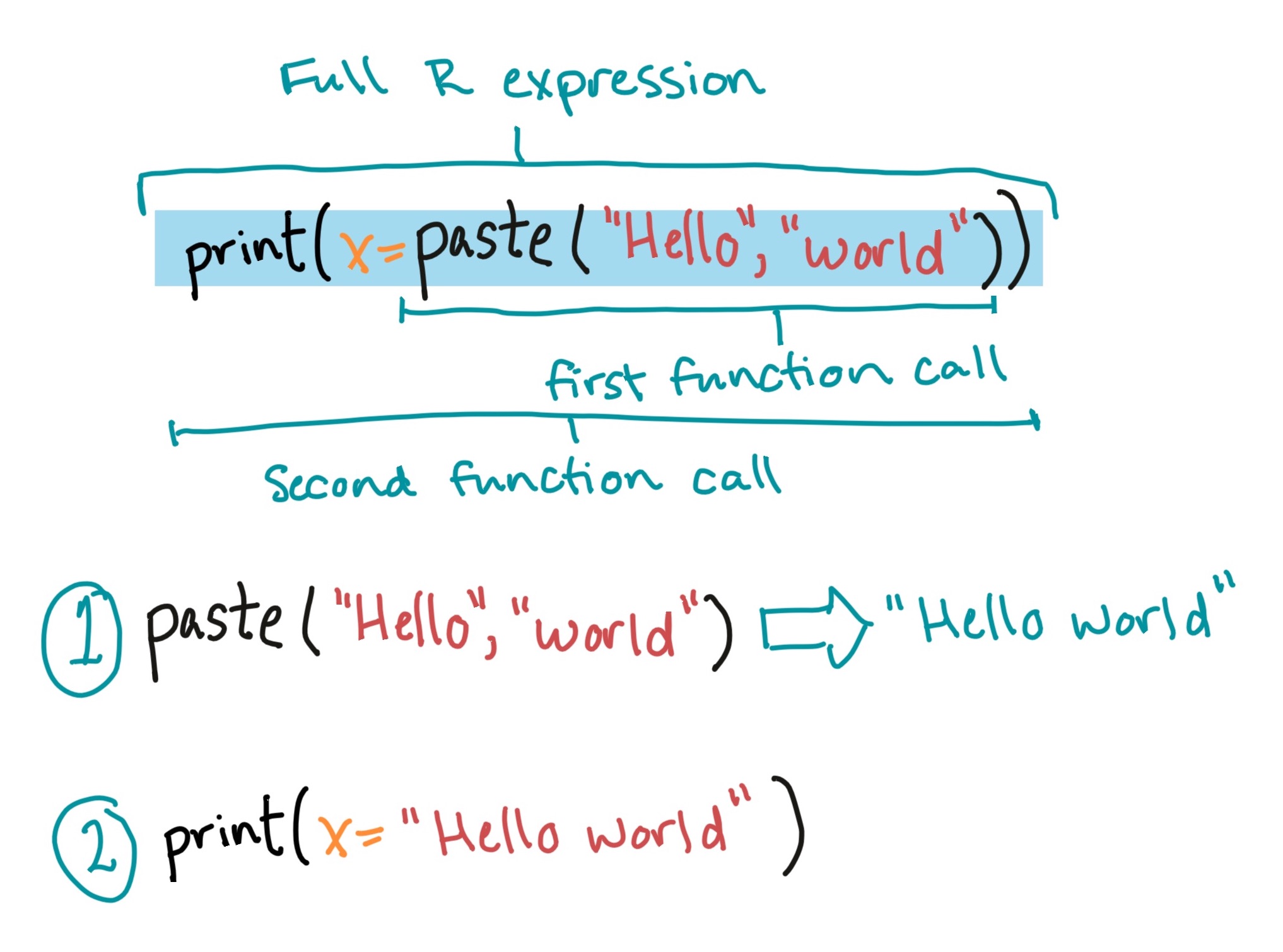
Figure 2.7: ‘Environment’ pane in RStudio. This shows the names and first few values of all objects that have been assigned to object names in the global environment.
2.4 R scripts
This is a good point in learning R for you to start putting your code in R scripts, rather than entering commands at the console.
An R script is a plain text file where you can save a series of R commands. You can save the script and open it up later to see or re-do what you did earlier, just like you could with something like a Word document when you’re writing a paper.
To open a new R script in RStudio, go to the menu bar and select “File” -> “New File” -> “R Script”. Alternatively, you can use the keyboard shortcut Command-Shift-N. Figure 2.8 gives an example of an R script file opened in RStudio and points out some interesting elements.
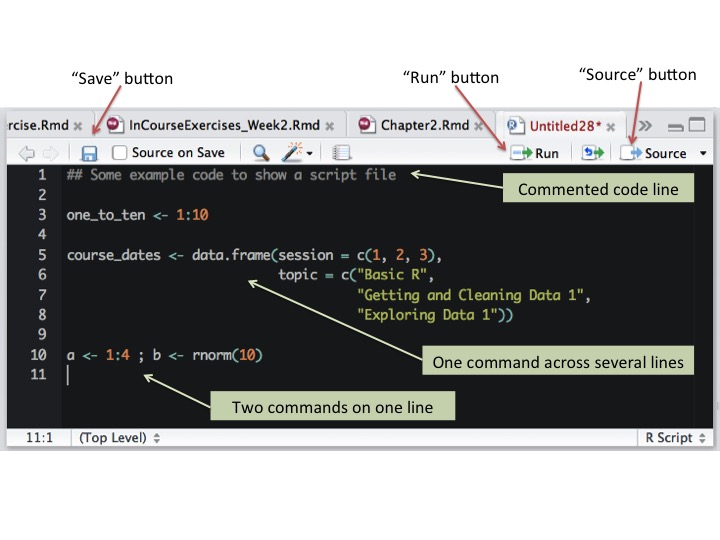
Figure 2.8: Example of an R script in RStudio.
To save a script you’re working on, you can click on the “Save” button, which looks like a floppy disk, at the top of your R script window in RStudio or use the keyboard shortcut Command-S. You should save R scripts using a “.R” file extension.
Within the R script, you’ll usually want to type your code so there’s one
command per line. If your command runs long, you can write a single call over
multiple lines. It’s unusual to put more than one command on a single line of a
script file, but you can if you separate the commands with semicolons (;).
These rules all correspond to how you can enter commands at the console.
Running R code from a script file is very easy in RStudio. You can use either the “Run” button or Command-Return, and any code that is selected (i.e., that you’ve highlighted with your cursor) will run at the console. You can use this functionality to run a single line of code, multiple lines of code, or even just part of a specific line of code. If no code is highlighted, then R will instead run all the code on the line with the cursor and then move the cursor down to the next line in the script.
You can also run all of the code in a script. To do this, use the “Source”
button at the top of the script window. You can also run the entire script
either from the console or from within another script by using the source()
function, with the filename of the script you want to run as the argument. For
example, to run all of the code in a file named “MyFile.R” that is saved in
your current working directory, run:
While it’s generally best to write your R code in a script and run it from
there rather than entering it interactively at the R console, there are some
exceptions. A main example is when you’re initially checking out a dataset to
make sure you’ve imported it correctly. It often makes more sense to run
commands for this task, like str(), head(), tail(), and summary(), at
the console. These are all examples of commands where you’re trying to look at
something about your data right now, rather than code that builds toward
your analysis, or helps you import or wrangle your data.
2.4.1 Commenting code
Sometimes, you’ll want to include notes in your code. You can do this in all
programming languages by using a comment character to start the line with
your comment. In R, the comment character is the hash symbol, #. You can add
comments into an R script to let others know (and remind yourself) what you’re
doing and why. Any line on a script line that starts with # will not be read
by R. You can also take advantage of commenting to comment out certain parts of
code that you don’t want to run at the moment. But, make sure to finalize your
R scripts with only functional code and useful comments. R will skip any line
that starts with # in a script. For example, if you run the following code:
# Don't print this.
"But print this"
R will only print the second, uncommented line.
You can also use a comment in the middle of a line, to add a note on what you’re doing in that line of the code. R will skip any part of the code from the hash symbol on. For example:
## [1] "Print this"There’s usually no reason to use code comments when running commands at the R console; however, it’s very important to get in the practice of including meaningful comments in R scripts. This helps you remember what you did when you revisit your code later.
“You know you’re brilliant, but maybe you’d like to understand what you did 2 weeks from now.” – Linus Torvalds
2.5 The “package” system
2.5.1 R packages
“Any doubts about R’s big-league status should be put to rest, now that we have a Sudoku Puzzle Solver. Take that, SAS!” – David Brahm (announcing the
sudokupackage), R-packages (January 2006)
Your original download of R is only a starting point. You can expand functionality of R with what are called packages, or extensions with new code and functionality that add to the basic “base R” environment. To me, this is a bit like this toy train set. You first buy a very basic set that looks something like Figure 2.9.
Figure 2.9: The toy version of base R.
To take full advantage of R, you’ll want to add on packages. In the case of the train set, at this point, a doting grandparent adds on extensively through birthday presents, so you end up with something that looks like Figure 2.10.
Figure 2.10: The toy version of what your R set-up will look like once you find cool packages to use for your research.
Each package is basically a bundle of extra R functions. They may also include help documentation, datasets, and some other objects, but typically the heart of an R package is the new functions it provides.
You can get these “add-on” packages in a number of ways. The main source for installing packages for R remains the Comprehensive R Archive Network, or CRAN. However, GitHub is growing in popularity, especially for packages that are still in active development. You can also create and share packages among your collaborators or co-workers, without ever posting them publicly.
2.5.2 Installing from CRAN

Figure 2.11: Celebrating CRAN’s 10,000th package, which was developed by Dr. Brooke Anderson.
The most popular place from which to download packages is currently CRAN, which
has over 10,000 R packages available (Figure 2.11). You can
install packages from CRAN using R code, with the install.packages()
function. For example, telephone keypads include letters for each number
(Figure 2.12), which allow companies to have “named” phone
numbers that are easier for people to remember, like 1-800-GO-FEDEX and
1-800-FLOWERS.
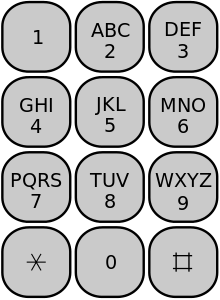
Figure 2.12: Telephone keypad with letters corresponding to each number.
The phonenumber package is a cool little package that will convert between
numbers and letters based on the telephone keypad. Since this package is on
CRAN, you can install the package to your computer using the
install.packages() function:
This downloads the package from CRAN and saves it in a special location on your
computer where R can load it when you’re ready to use it. Once you’ve installed
a package to your computer this way, you don’t need to re-run this
install.packages() for the package ever again, unless the package maintainer
posts an updated version.
Just like R itself, packages often evolve and are updated by their maintainers. You should update your packages as new versions come out. Typically, you have to reinstall packages when you update your version of R, so this is a good chance to get the most up-to-date version of the packages you use.
2.5.3 Loading an installed package
Once you have installed a package, it will be saved to your computer. But, you won’t be able to access its functions within an R session until you load it in that R session. Loading a package essentially makes all of the package’s functions available to you.
You can load a package in an R session using the library() function, with the
package name inside the parentheses.
Figure 2.13 provides a conceptual picture of the different steps of installing and loading a package.
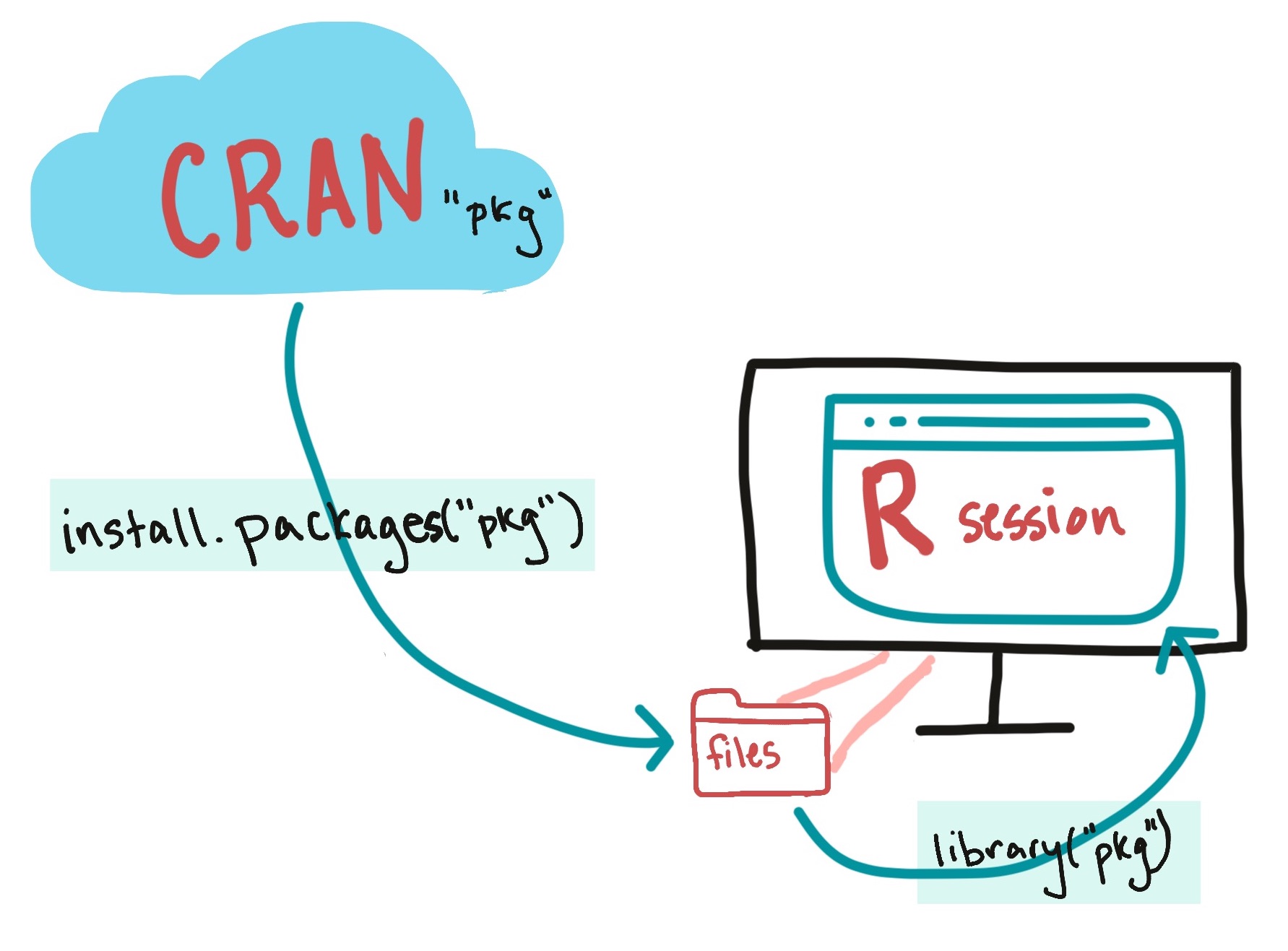
Figure 2.13: Install a package (with install.packages()) to get it onto your computer. Load it (with library()) to get it into your R session.
Once a package is loaded, you can use all its exported (i.e., public) functions
by calling them directly. For example, the phonenumber package has a function
called letterToNumber() that converts a character string to a number. If you
have not loaded the phonenumber package in your current R session and try to
use this function, you will get an error. Once you’ve loaded phonenumber
using the library() function, you can use this function in your R session:
## [1] "4633339"R vectors can have several different classes. One common class is the character class, which is the class of the character string we’re using here (“GoFedEx”). You’ll always put character strings in quotation marks. Another key class is numeric (numbers). Later in the course, we’ll introduce other classes that vectors can have, including factors and dates. For the simplest vector classes, these classes are determined by the type of data that the vector stores.
When you open RStudio, unless you reload the history of a previous R session (which I strongly do not recommend), you will start your work in a “fresh” R session. This means that, once you open RStudio, you will need to run the code to load any packages, define any objects, and read in any data that you will need for analysis in that session.
If you are using a package in academic research, you should cite it, especially
if it implements a nonstandard algorithm or method. You can use the
citation() function to get the information you need about how to cite a
package:
## To cite package 'phonenumber' in publications use:
##
## Myles S (2021). _phonenumber: Convert Letters to Numbers and Back as
## on a Telephone Keypad_. doi:10.32614/CRAN.package.phonenumber
## <https://doi.org/10.32614/CRAN.package.phonenumber>, R package
## version 0.2.3, <https://CRAN.R-project.org/package=phonenumber>.
##
## A BibTeX entry for LaTeX users is
##
## @Manual{,
## title = {phonenumber: Convert Letters to Numbers and Back as on a Telephone Keypad},
## author = {Steve Myles},
## year = {2021},
## note = {R package version 0.2.3},
## url = {https://CRAN.R-project.org/package=phonenumber},
## doi = {10.32614/CRAN.package.phonenumber},
## }
We’ve talked here about loading packages using the
library() function to access their functions. This is not
the only way to access the package’s functions. The syntax
[package name]::[function name] will allow you to use a
function from a package you have installed on your computer, even if its
package has not been loaded in the current R session. Typically, this
syntax is not used much in data analysis scripts, in part because it
makes the code much longer. You will occasionally see it in learning
contexts to build familiarity with the package::function connection and
in which package a function exists. It is also used to distinguish
between two functions from different packages that have the same name,
as this format makes the desired function unambiguous. One example where
this syntax often is needed is when both plyr and
dplyr packages are loaded in an R session, since these
share functions with the same name.
Packages typically include some documentation to help users. These include:
- Package vignettes: Longer, tutorial-style documents that walk the user through the basics of how to use the package and often give some helpful example cases of the package in use.
- Function helpfiles: Files for each user-facing function within the package, following an established structure. These include information about what inputs are required and optional for the function, what output will be created, and what options can be selected by the user. In many cases, these also include examples of using the function.
To determine which vignettes are available for a package, you can use the
vignette() function, with the package’s name specified for the package
option:
From the output of this, you can call any of the package’s vignettes directly.
For example, the previous call tells you that this package only has one
vignette, and that vignette has the same name as the package (“phonenumber”).
Once you know the name of the vignette you would like to open, you can also use
vignette() to open it:
To access the helpfile for any function within a package you’ve loaded, you can
use ? followed by the function’s name, but note the lack of ():
2.6 R’s most basic object types
An R object stores some type of data that you want to use later in your R code,
without fully recreating it. The content of R objects can vary from very simple
(e.g., "GoFedEx" string in the example code above) to very complex objects
with lots of elements (e.g., machine learning model).
Objects can be structured in different ways, in terms of how they “hold” data. These difference structures are called object classes. One class of objects can be a subtype of a more general object class.
There are a variety of different object types in R, shaped to fit different types of objects, from the simple to complex. In this section, we’ll start by describing two object types that you will use most often in basic data analysis: vectors (one-dimensional objects) and dataframes (two-dimensional objects).
For these two object classes (vectors and dataframes), we’ll look at:
- How that class is structured
- How to make a new object with that class
- How to extract values from objects with that class
2.6.1 Vectors
To get an initial grasp of the vector object type in R, think of it as a one-dimensional object, or a string of values. Figure 2.14 provides an example of the structure for a very simple vector, one that holds the names of three of the main characters in the first episode of the Hunger Games series.

Figure 2.14: An example of the structure of an R object with the vector class. This object class contains data as a string of values, all with the same data type.
All values in a vector must be of the same data type (i.e., all numbers, all characters, or all dates). If you try to create a vector with elements from different types (e.g., vector of “FedEx”, which is a character, and 3, a number), R will coerce all of the elements to the most generic class of the included elements (e.g., “FedEx” and “3” will both become characters, since “3” can be changed to a character, but “FedEx” can’t be changed to a number). Figure 2.15 gives some examples of different classes of vectors.
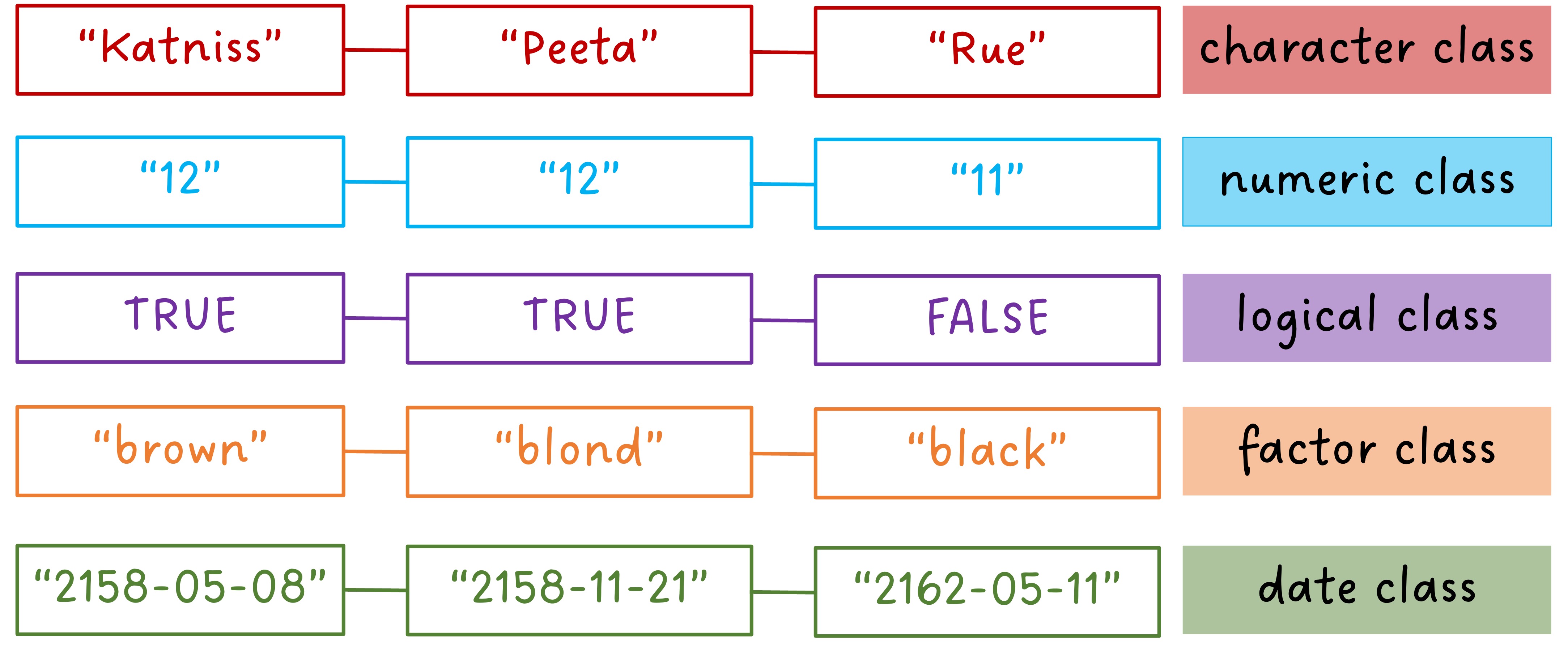
Figure 2.15: Examples of vectors of different classes. All the values in a vector must be of the same type (e.g., all numbers or all characters). There are different classes of vectors depending on the type of data they store.
To create a vector from different elements, you’ll use the concatenate
function, c() to join them together, with commas between the elements;
concatenate is a fancy word that means “to link together”. For example, to
create the vector shown in Figure 2.14, you
can run:
## [1] "Katniss" "Peeta" "Rue"If you want to use that object later, you can assign it an object name in the expression:
## [1] "Katniss" "Peeta" "Rue"This assignment expression, for assigning a vector an object name, follows the structure we covered earlier for function calls and assignment expressions (Figure 2.16).

Figure 2.16: Elements of the assignment expression for creating a vector and assigning it an object name.
If you create a numeric vector, you should not put the values in quotation marks:
If you mix classes when you create the vector, R will coerce all the elements to most generic class of the included elements:
## [1] "1" "3" "five"Notice that the two integers, 1 and 3, are now in quotation marks because they
were put in a vector with a value with the character data type. You can use the
class() function to determine the class of an object:
## [1] "character"A vector’s length is the number of elements in the vector. You can use the
length() function to determine a vector’s length:
## [1] 3Once you create an object, you will often want to reference the whole object in
future code. Nonetheless, there will be some times when you’ll want to
reference only certain elements of the object. You can pull out certain values
from a vector by using indexing with square brackets ([...]) to identify the
locations of the element you want to extract. For example, to extract the
second element of the main_characters vector, you can run:
## [1] "Peeta"You can use this same method to extract more than one value. You just need to
create a numeric vector with the position of each element you want to extract
and pass that in the square brackets. For example, to extract the first and
third elements of the main_characters vector, you can run:
## [1] "Katniss" "Rue"The : operator can be very helpful with extracting values from a vector.
This operator creates a sequence of values from the value before the : to the
value after :, going by units of 1. For example, if you want to create a list
of the numbers between 1 and 10, you can run:
## [1] 1 2 3 4 5 6 7 8 9 10If you want to extract the first two values from the main_characters vector,
you can use the : operator:
## [1] "Katniss" "Peeta"You can also use logic to pull out some values of a vector. For example, you
might only want to pull out even values from the fibonacci vector.
One thing that people often find confusing when they start using R is knowing when to use and not use quotation marks. The general rule is that you use quotation marks when you want to refer to a character string literally, but no quotation marks when you want to refer to the value in a previously-defined object.
For example, if you saved the string “Volckens” as the
object my_name (my_name <- “Volckens”),
then in later code, if you type my_name (no quotation
marks), you’ll get “Volckens”, while if you type out
“my_name” (with quotation marks), you’ll get
“my_name” (what you typed).
One thing that makes this rule confusing is that there are a few
cases in R where you really should, following this rule, use quotation
marks, but the function is coded to let you be lazy and get away without
them. One example is the library() function. In the code
earlier in this section to load the “phonenumber” package, you want to
load the package “phonenumber” (with quotation marks), rather than load
whatever character string is saved in the object named
phonenumber. But, library() is one of the
functions where you can be lazy and skip the quotation marks, and it
will still load the package. Therefore, this function works if you do or
do not use quotation marks around the package name.
2.6.2 Dataframes
A dataframe is a two-dimensional object made of one or more vectors of the same length stuck together side-by-side. It is the closest R has to an Excel spreadsheet-type structure. Figure 2.17 gives a conceptual example of a dataframe created from several of the vector examples in Figure 2.15.
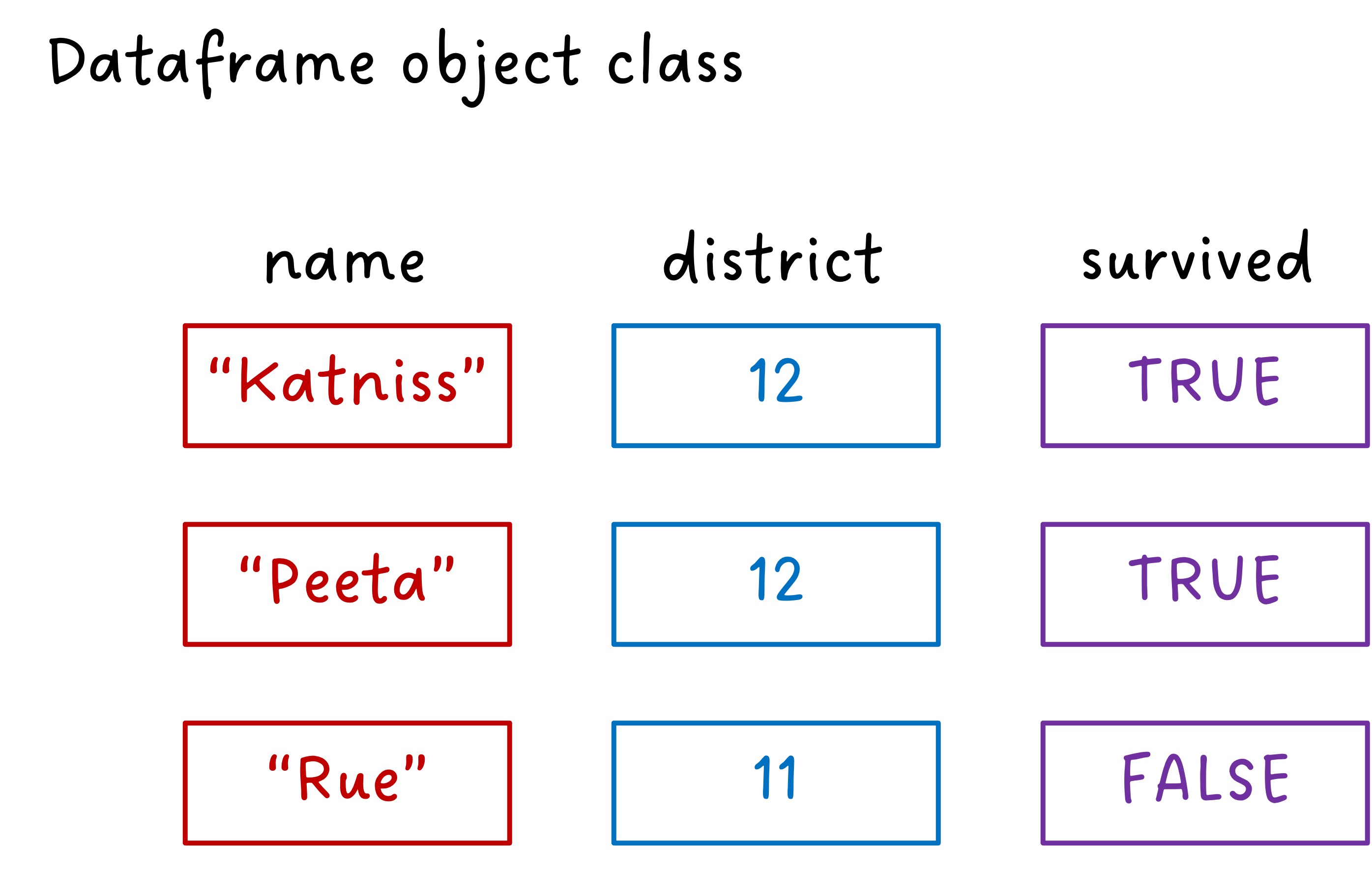
Figure 2.17: An example dataframe created from several vectors of the same length and with observations aligned across vector positions. For example, the first value in each vector provides a value for Katniss, the second for Peeta.
Here’s how the dataframe in Figure 2.17 will look in R:
## # A tibble: 3 × 3
## first_name district survived
## <chr> <dbl> <lgl>
## 1 Katniss 12 TRUE
## 2 Peeta 12 TRUE
## 3 Rue 11 FALSEThis dataframe is arranged in rows and columns, with names for each column
(Figure 2.18). Note that each row of this dataframe
gives a different observation. In this case, our unit of observation is a Hunger Games
character. Each column gives a different type of information, including
first name, residential district, and whether they’re still alive after the first book/film. Notice that the number of elements in
each of the columns must be the same in this dataframe, but that the different
columns can have different classes of data (e.g., character vectors for
name; logical value of TRUE or FALSE for survived).
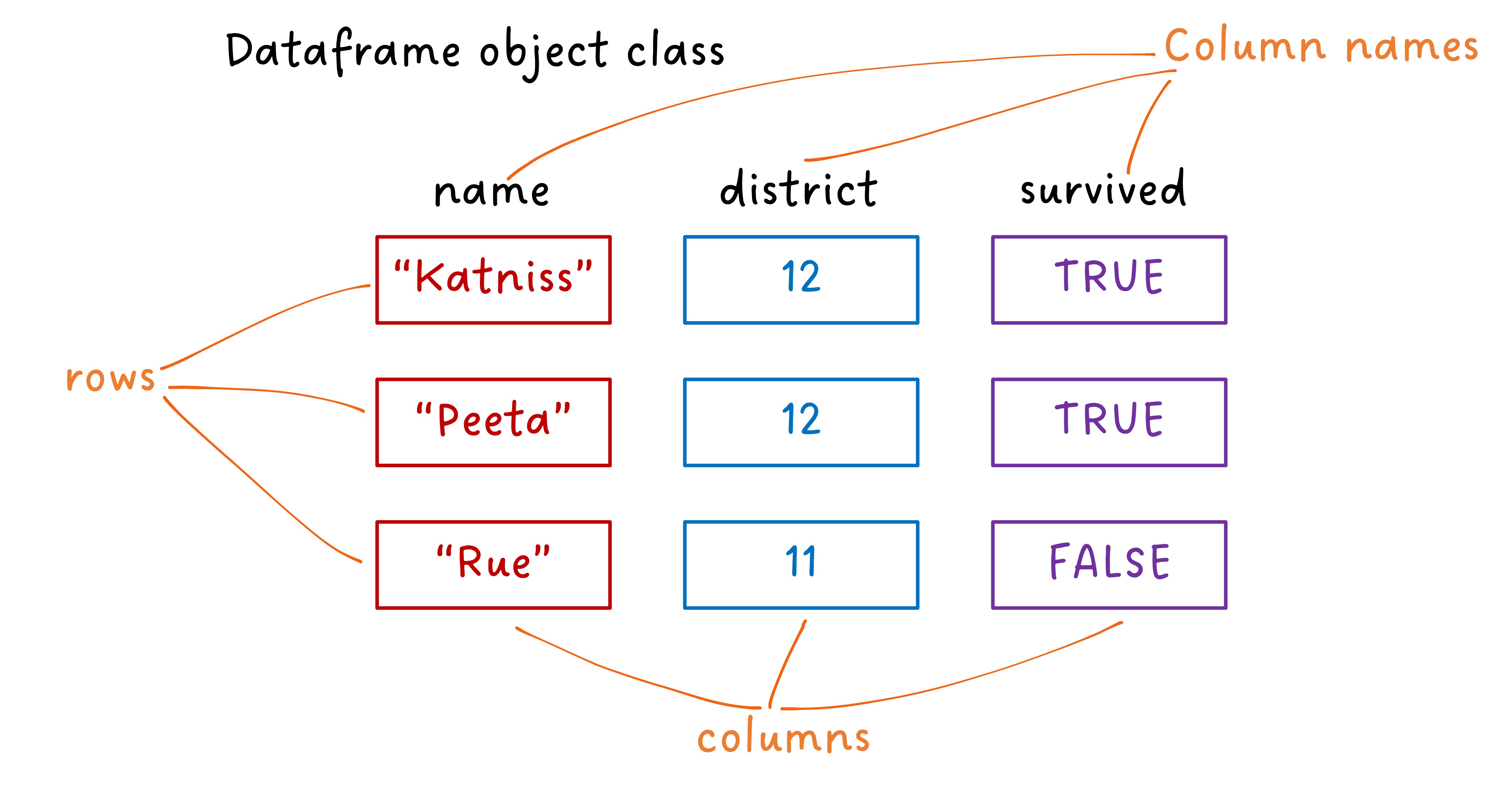
Figure 2.18: The elements of a dataframe: columns, rows, and column names.
We will be working with a specific class of dataframe called a tibble. You
can create tibble dataframes using the tibble() function from the tibble
package. Most often you will create a dataframe by reading in data from a file,
using something like read_csv() from the readr package.
There are base R functions for both of these tasks (i.e.,
data.frame() and read.csv(), respectively),
eliminating the need to load additional packages with a
library() call. The series of packages that make up what’s
called the “tidyverse” have brought a huge improvement in the ease and
speed of working with data in R. We will be teaching these tools in this
course, and that’s why we’re going directly to tibble() and
read_csv() from the start, rather than base R equivalents.
Later in the course, we’ll talk more about this “tidyverse” and what
makes it so great.
To create a dataframe, you can use the tibble() function from the tibble
package. The general format for using tibble() is:
## generic code; will not run
[name of object] <- tibble([1st column name] = [1st column content],
[2nd column name] = [2nd column content])with an equals sign between the column name and column content for each column,
and commas between each of the columns. Here is an example of the code used to
create the Hunger Games tibble dataframe shown above:
library(package = "tibble")
hg_data <- tibble(first_name = c("Katniss", "Peeta", "Rue"),
district = c(12, 12, 11),
survived = c(TRUE, TRUE, FALSE))
hg_data## # A tibble: 3 × 3
## first_name district survived
## <chr> <dbl> <lgl>
## 1 Katniss 12 TRUE
## 2 Peeta 12 TRUE
## 3 Rue 11 FALSEYou can also create a dataframe by sticking together vectors you already have saved as R objects. For example:
hg_data <- tibble(first_name = main_characters,
district = district,
survived = c(TRUE, TRUE, FALSE))
hg_data## # A tibble: 3 × 3
## first_name district survived
## <chr> <dbl> <lgl>
## 1 Katniss 12 TRUE
## 2 Peeta 12 TRUE
## 3 Rue 11 FALSENote that this call requires the main_characters and district vectors to be
the same length. They don’t have to be, and, in this case, are not, the same
class of objects. Specifically, main_characters is a character class, and
district is numeric.
You can put more than one function call in a single line of R code,
as in this example. The c() creates a vector, while the
tibble() creates a dataframe, using the vectors created by
the calls to c(). When you use multiple functions within a
single R call, R will evaluate starting from the inner-most parentheses
outward, much like the order of mathematical operations.
So far, we’ve only seen how to create dataframes from scratch within an R
session. Usually, however, you’ll create R dataframes by reading in data from
an outside file using the read_csv() from the readr package or other
related functions. For example, you might want to analyze data on all the
guests that came on the Daily Show, circa Jon Stewart. If you have this
data in a comma-separated (csv) file on your computer called
“daily_show_guests.csv”, you can read it into your R session with the following
code:
In this code, the read_csv() function is reading in the data from the file
“daily_show_guests.csv”, while the “gets arrow” (<-) assigns that data to the
object daily_show, which you can then reference in later code to explore and
plot the data.
You can use the functions dim(), nrow(), and ncol() to figure out the
dimensions (i.e., number of rows and columns) of a dataframe:
## [1] 2693 5## [1] 2693## [1] 5Base R also has some useful functions for quickly exploring dataframes:
str(): Show the structure of an R object, including a dataframesummary(): Give summaries of each column of a dataframe.
For example, you can explore the data we just pulled in on the Daily Show with:
## spc_tbl_ [2,693 × 5] (S3: spec_tbl_df/tbl_df/tbl/data.frame)
## $ YEAR : num [1:2693] 1999 1999 1999 1999 1999 ...
## $ GoogleKnowlege_Occupation: chr [1:2693] "actor" "Comedian" "television actress" "film actress" ...
## $ Show : chr [1:2693] "1/11/99" "1/12/99" "1/13/99" "1/14/99" ...
## $ Group : chr [1:2693] "Acting" "Comedy" "Acting" "Acting" ...
## $ Raw_Guest_List : chr [1:2693] "Michael J. Fox" "Sandra Bernhard" "Tracey Ullman" "Gillian Anderson" ...
## - attr(*, "spec")=
## .. cols(
## .. YEAR = col_double(),
## .. GoogleKnowlege_Occupation = col_character(),
## .. Show = col_character(),
## .. Group = col_character(),
## .. Raw_Guest_List = col_character()
## .. )
## - attr(*, "problems")=<externalptr>## YEAR GoogleKnowlege_Occupation Show Group
## Min. :1999 Length:2693 Length:2693 Length:2693
## 1st Qu.:2003 Class :character Class :character Class :character
## Median :2007 Mode :character Mode :character Mode :character
## Mean :2007
## 3rd Qu.:2011
## Max. :2015
## Raw_Guest_List
## Length:2693
## Class :character
## Mode :character
##
##
## To extract data from a dataframe, you can use some functions from the dplyr
package, including select() and slice(). The select() function will pull
out columns, while the slice() function will extract rows. In this chapter,
we’ll talk about how to extract certain rows or columns of a dataframe by
their position (i.e., based on row or column number). For example, if you
wanted to get the first two rows of the hg_data dataframe, you could run:
## # A tibble: 2 × 3
## first_name district survived
## <chr> <dbl> <lgl>
## 1 Katniss 12 TRUE
## 2 Peeta 12 TRUEIf you wanted to get the first and third columns, you could run:
## # A tibble: 3 × 2
## first_name survived
## <chr> <lgl>
## 1 Katniss TRUE
## 2 Peeta TRUE
## 3 Rue FALSEYou can compose calls from both functions. For example, you could extract the values in the first and third columns of the first two rows with:
## # A tibble: 2 × 2
## first_name survived
## <chr> <lgl>
## 1 Katniss TRUE
## 2 Peeta TRUEYou can use square-bracket indexing ([..., ...]) for dataframes, too, but you
will need to manage two dimensions: rows and columns. Put the rows you want
before the comma and the columns after; if you want all rows or all columns,
leave the corresponding spot blank. Here are two examples of using
square-bracket indexing to pull a subset of the hg_data dataframe:
## # A tibble: 2 × 1
## district
## <dbl>
## 1 12
## 2 12## # A tibble: 1 × 3
## first_name district survived
## <chr> <dbl> <lgl>
## 1 Rue 11 FALSE
If you forget to put the comma in the indexing for a dataframe (e.g.,
fibonacci_seq[1:2]), you will index out the
columns that fall at that position or positions. To avoid
confusion, I suggest that you always use indexing with a comma when
working with dataframes.
2.7 Chapter 2 Exercises
2.7.1 Set 1: Session, helpfiles, scripts, and objects
Within your R project for this course, open a “fresh” R session (Session > Restart R, if RStudio is already open). Using
getwd()in the console, confirm the working directory is your R project.Type
sessionInfo()into the console. What R version are you using? What base R packages were loaded automatically in your R session?Still in the console and using
?, open and examine the helpfile for one of the base R packages named above. Use the function listed in the “Details” section of the helpfile to call the full package documentation, including a list of functions. Call and examine the helpfile for one of these functions.Go to File > New File > R Script to open a new R script. Add your name to the top of the R script as a comment. Call
mtcars(dataset about cars in base R) in the console. Then, using thegets arrow, savemtcarsas an object namedmtcars_datain your R script. Saving the relevant commands in the R script, examine the structure ofmtcars_dataand determine its dimensions and variable class types (e.g., numeric, logical). Save your R script with an informative file name (e.g., “class-activity-DATE”) in the/codefolder of your R project and commit your changes to GitHub with a meaningful commit message and push the changes.
2.7.1.1 Example Code
- Working directory
- Session information
- Helpfiles
# call main helpfile for whole base R package
?stats
# use function from Details section to call list of functions
base::library(help = "stats")
# call helpfile for one function
?lm- Object assignment
# load and view mtcars data
mtcars
# assign data as object in environment
mtcars_data <- mtcars
# view structure of mtcars_data
str(mtcars_data)
# a tidyverse alternative to `str()`
## extra: https://stackoverflow.com/questions/23660094/whats-the-difference-between-integer-class-and-numeric-class-in-r
tibble::glimpse(mtcars_data)
# assess dimensions of mtcars_data
dim(mtcars_data)
# determine variable class types (by individual variable)
class(mtcars_data$mpg)There are 32 observations (vehicle models) and 11 variables, all of which are numeric.
2.7.2 Set 2: Loading and using packages
Reopen the R script from the above set of exercises. Install
dplyr, a popular R package for data wrangling, from your console. In your R script, loaddplyr. Usingdplyr::filter(), determine the number of cars inmtcars_datawith an average miles per gallon (mpg) above 25. Save the R script and commit the changes to GitHub with a meaningful commit message; push the changes.Navigate to the “Tutorial” tab in your environment panel. Complete the “Data Basics” tutorial via
learnr.
2.8 Chapter 2 Homework
During the next few class periods and for homework, you will complete ten
lessons in swirl, an R package for learning R
in R, written by Roger Peng, Brooke Anderson, and Sean Kross. Each lesson
might take 10-15 minutes.
In a text file, record the lesson names and a very brief description of what
you learned from each. Save this file in your local R Project in the
appropriate directory (e.g., /homework) and commit/push the file with regular
updates to your private GitHub repository.
Follow the steps here
to install, load,
and start swirl. When you are prompted to install a course, you can load “R
Programming,” which covers material related to the recent class lectures. If
you are already familiar with this content, feel free to select a different
course such as “Exploratory Data Analysis.”
Please complete the following swirl lessons:
- Module 1: Basic Building Blocks
- Module 2: Workspace and Files
- Module 3: Sequences of Numbers
- Module 4: Vectors
- Module 5: Missing Values
- Module 6: Subsetting Vectors
- Module 7: Matrices and Data Frames
- Module 8: Logic
- Module 9: Functions
- Module 12: Looking at Data
swirl lessons have a mix of base R and tidyverse approaches, so don’t be
alarmed or discouraged if you see some unfamiliar techniques or concepts. If
you are interested in learning more about something from swirl, Google is a
great place to start. We will cover a lot of the material later in the class.
2.8.1 Special swirl commands
In the swirl environment, knowing about the following commands will be
helpful:
- The prompt
...indicates you should press enter to continue in the lesson. skip(): skip current questionplay(): temporarily exitswirlnxt(): return toswirlafterplay()ing around in the consolemain(): return toswirl’s main menubye()or “escape” key: exitswirl